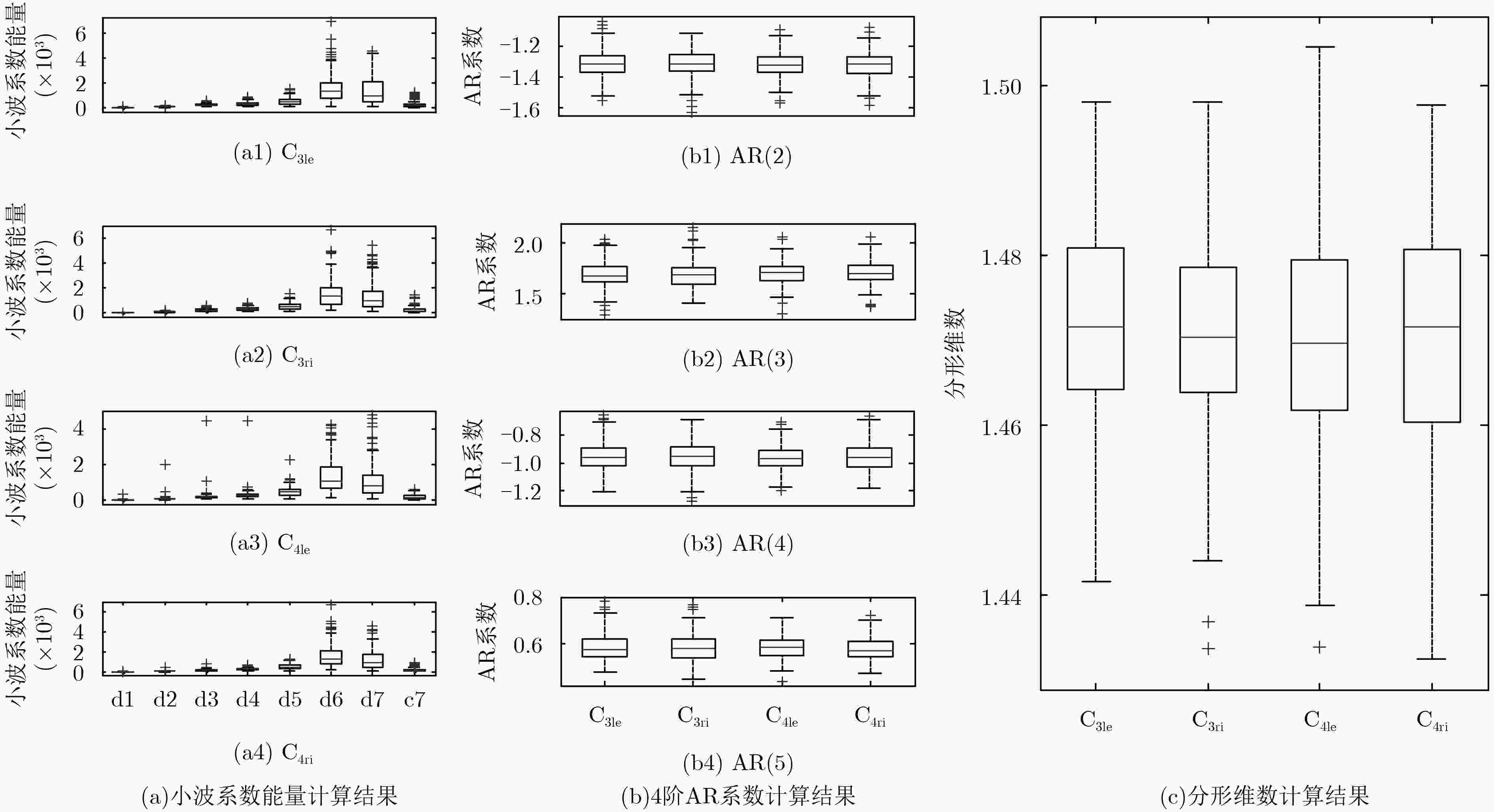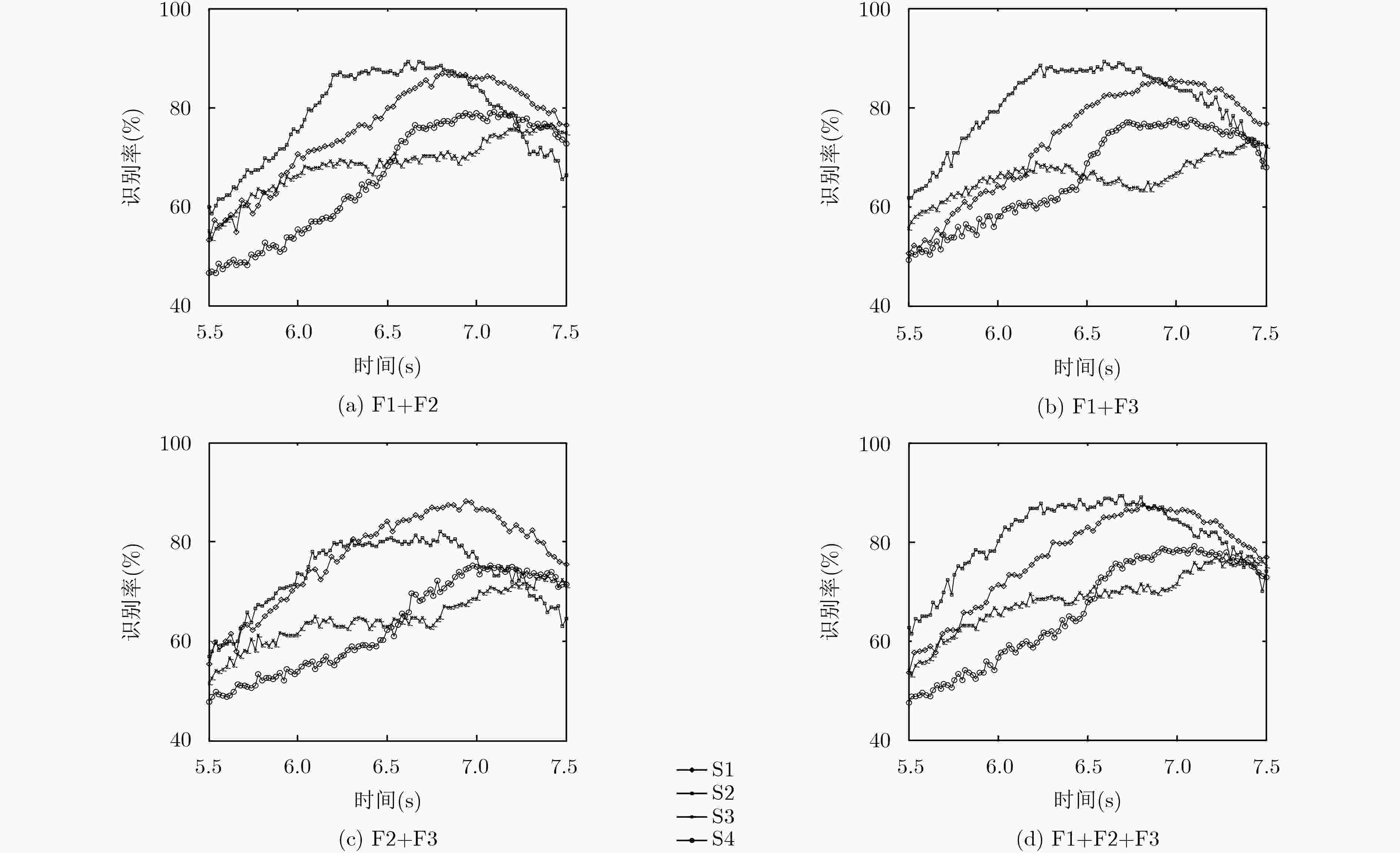Research of Discrimination Between Left and Right Hand Motor Imagery EEG Patterns Based on Tunable Q-Factor Wavelet Transform
-
摘要:
针对识别左右手运动想象脑电图信号(EEG)模式精度和互信息不高的问题,该文采用基于可调Q因子小波变换(TQWT)算法来处理脑电信号。首先,利用TQWT对脑电图信号进行分解;随后,提取子频带信号的小波系数能量、自回归模型(AR)系数以及分形维数;最后,利用线性判别分析(LDA)对提取的脑电特征进行识别。采用BCI2003和BCI2005竞赛数据对所提出的算法进行验证,4名受试者的最高识别率分别为88.11%, 89.33%, 77.13%和78.80%,最大互信息分别为0.95, 0.96, 0.43和0.45。实验结果表明,所提算法取得了高分类精度及互信息值,验证了其有效性。
Abstract:In view of the problem of low accuracy and mutual information in left and right hand motor imagery-based ElectroEncephaloGram (EEG), a new approach based on Tunable Q-factor Wavelet Transform (TQWT) is proposed to handle with the binary-class motor imagery EEGs. Firstly, the TQWT is utilized to decompose the filtered EEG signal. Then, several sub-band signals are extracted and followed by calculating their energy, AutoRegressive (AR) model coefficients and fractal dimension. Finally, a Linear Discriminant Analysis (LDA) classifier is used to classify these EEGs. Two Graz datasets of BCI Competition 2003 and 2005 are employed to verify the proposed method. The maximum accuracy of classifying EEGs of four subjects is 88.11%, 89.33%, 77.13% and 78.80%, respectively, and the maximum mutual information is 0.95, 0.96, 0.43 and 0.45. The high accuracies and mutual information demonstrate eventually the effectiveness of the proposed method.
-
表 1 不同受试者采用单一特征和组合特征所得平均识别率及最高识别率
受试者 特征组合 平均识别率(%) 最高识别率(%) F1 81.74 86.44 F2 80.95 85.66 F3 67.93 73.38 S1 F1+F2 86.16 86.90 F1+F3 84.76 85.47 F2+F3 85.03 86.89 F1+F2+F3 86.45 88.11 F1 84.20 89.04 F2 76.52 81.06 F3 55.87 61.20 S2 F1+F2 87.85 89.30 F1+F3 87.63 88.59 F2+F3 80.22 81.33 F1+F2+F3 87.96 89.33 F1 66.08 71.46 F2 66.30 68.93 F3 55.16 58.92 S3 F1+F2 75.61 76.99 F1+F3 71.40 73.08 F2+F3 71.49 72.72 F1+F2+F3 74.70 77.13 F1 73.24 77.87 F2 69.10 74.60 F3 52.36 58.34 S4 F1+F2 77.65 78.79 F1+F3 76.14 77.24 F2+F3 74.06 75.25 F1+F2+F3 76.73 78.80 表 4 不同受试者TQWT参数设置
受试者 Q r J S1 1 3 2 S2 2 3 7 S3 1 3 2 S4 2 3 3 表 5 本文方法的时耗统计(s)
TQWT过程 能量特征 AR系数特征 分形维数特征 分类 总时间 S1 0.0010 0.0012 0.0016 0.0559 0.0174 0.0771 S2 0.0022 0.0010 0.0015 0.0536 0.0166 0.0749 S3 0.0012 0.0010 0.0016 0.0533 0.0163 0.0734 S4 0.0014 0.0015 0.0018 0.0547 0.0171 0.0765 -
佘青山, 陈希豪, 高发荣. 基于感兴趣脑区LASSO-Granger因果关系的脑电特征提取算法[J]. 电子与信息学报, 2016, 38(5): 1266–1270. doi: 10.11999/JEIT150851SHE Qingshan, CHEN Xihao, and GAO Farong. Feature extraction of electroencephalography based on LASSO-Granger causality between brain region of interest[J]. Journal of Electronics &Information Technology, 2016, 38(5): 1266–1270. doi: 10.11999/JEIT150851 BALCONI M and MAZZA G. Brain oscillations and BIS/BAS (behavioral inhibition/activation system) effects on processing masked emotional cues. ERS/ERD and coherence measures of alpha band[J]. International Journal of Psychophysiology, 2009, 74(2): 158–165. doi: 10.1016/j.ijpsycho.2009.08.006 吕俊, 谢胜利, 章晋龙. 脑-机接口中基于ERS/ERD的自适应空间滤波算法[J]. 电子与信息学报, 2009, 31(2): 314–318.LV Jun, XIE Shengli, and ZHANG Jinlong. Adaptive spatial filter based on ERD/ERS for brain-computer interfaces[J]. Journal of Electronics &Information Technology, 2009, 31(2): 314–318. 陈强, 陈勋, 余凤琼. 基于独立向量分析的脑电信号中肌电伪迹的去除方法[J]. 电子与信息学报, 2016, 38(11): 2840–2847. doi: 10.11999/JEIT160209CHEN Qiang, CHEN Xun, and YU Fengqiong. Removal of muscle artifact from EEG data based on independent vector analysis[J]. Journal of Electronics &Information Technology, 2016, 38(11): 2840–2847. doi: 10.11999/JEIT160209 CHEN Minyou, FANG Yonghui, and ZHENG Xufei. Phase space reconstruction for improving the classification of single trial EEG[J]. Biomedical Signal Processing & Control, 2014, 11(1): 10–16. doi: 10.1016/j.bspc.2014.02.002 HAMID M and ZABIHOLLAH S M. Improvement of EEG-based motor imagery classification using ring topology-based particle swarm optimization[J]. Biomedical Signal Processing & Control, 2017, 32: 69–75. doi: 10.1016/j.bspc.2016.10.015 PATTNAIK S, DASH M, and SABUT S K. DWT-based feature extraction and classification for motor imaginary EEG signals[C]. International Conference on Systems in Medicine and Biology, Kharagpur, India, 2016: 186–201. 徐佳琳, 左国坤. 基于互信息与主成分分析的运动想象脑电特征选择算法[J]. 生物医学工程学杂志, 2016, 33(2): 201–207. doi: 10.7507/1001-5515.20160036XU Jialin and ZUO Guokun. Motor imagery electroencephalogram feature selection algorithm based on mutual information and principal component analysis[J]. Journal of Biomedical Engineering, 2016, 33(2): 201–207. doi: 10.7507/1001-5515.20160036 罗志增, 周镇定, 周瑛. 双树复小波特征在运动想象脑电识别中的应用[J]. 传感技术学报, 2014, 27(5): 575–580. doi: 10.3969/j.issn.1004-1699.2014.05.001LUO Zhizeng, ZHOU Zhending, and ZHOU Ying. The application of DTCWT feature in recognition of motor imagery[J]. Journal of Sensors and Actuators, 2014, 27(5): 575–580. doi: 10.3969/j.issn.1004-1699.2014.05.001 周瑛. 虚拟场景下运动想象脑电信号识别研究[D]. [硕士论文], 杭州电子科技大学, 2013.ZHOU Ying. The research of motor imagery recognition in virtual reality[D]. [Master dissertation], Hangzhou Dianzi University, 2013. AL-QAZZAZ N K, HAMID B M A S, AHMAD S A, et al. Automatic artifact removal in EEG of normal and demented individuals using ICA-WT during working memory tasks[J]. Sensors, 2017, 17(6): 1–25. doi: 10.3390/s17061326 GHORBANIAN P, DEVILBISS D M, VERMA A, et al. Identification of resting and active state EEG features of Alzheimer’s disease using discrete wavelet transform[J]. Annals of Biomedical Engineering, 2013, 41(6): 1243–1257. doi: 10.1007/s10439-013-0795-5 HASSAN A R and BHUIYAN M I H. An automated method for sleep staging from EEG signals using normal inverse Gaussian parameters and adaptive boosting[J]. Neurocomputing, 2017, 219: 76–87. doi: 10.1016/j.neucom.2016.09.011 BENJAMIN B. BCI Competition II[OL]. http://www.bbci.de/competition/ii/, 2003. BENJAMIN B. BCI Competition III[OL]. http://www.bbci.de/competition/iii/, 2005. VIDAURRE C, SCHLOGL A, CABEZA R, et al. A fully on-line adaptive BCI[J]. IEEE Transactions on Biomedical Engineering, 2006, 53(6): 1214–1219. doi: 10.1109/TBME.2006.873542 BAYRAM I and SELESNICK I W. Frequency-domain design of overcomplete rational-dilation wavelet transforms[J]. IEEE Transactions on Signal Processing, 2009, 57(8): 2957–2972. doi: 10.1109/TSP.2009.2020756 IVAN S. Tunable Q-factor wavelet transform[OL]. http://eeweb.poly.edu/iselesni/TQWT/index.html, 2016. SELESNICK I W. Wavelet transform with tunable Q-factor[J]. IEEE Transactions on Signal Processing, 2011, 59(8): 3560–3575. doi: 10.1109/TSP.2011.2143711 AMIN H U, MALIK A S, AHMAD R F, et al. Feature extraction and classification for EEG signals using wavelet transform and machine learning techniques[J]. Australasian Physical & Engineering Sciences in Medicine, 2015, 38(1): 139–149. doi: 10.1007/s13246-015-0333-x LAWHERN V, HAIRSTON W D, MCDOWELL K, et al. Detection and classification of subject-generated artifacts in EEG signals using autoregressive models[J]. Journal of Neuroscience Methods, 2012, 208(2): 181–189. doi: 10.1016/j.jneumeth.2012.05.017 PHOTHISONOTHAI M and NAKAGAWA M. EEG-based classification of motor imagery tasks using fractal dimension and neural network for brain-computer interface[J]. IEICE Transactions on Information and Systems, 2008, 91(1): 44–53. doi: 10.1093/ietisy/e91-d.1.44 訾艳阳, 胥永刚, 何正嘉. 离散振动信号分形盒维数的改进算法和应用[J]. 机械科学与技术, 2001(3): 373–376. doi: 10.3321/j.issn:1003-8728.2001.03.021ZI Yanyang, XU Yonggang, and HE Zhengjia. Fractal box dimension of discrete vibration signals[J]. Mechanical Science and Technology for Aerospace Engineering, 2001(3): 373–376. doi: 10.3321/j.issn:1003-8728.2001.03.021 GUPTA S and SAINI H. EEG features extraction using PCA plus LDA approach based on L1-norm for motor imaginary classification[C]. IEEE International Conference on Computational Intelligence and Computing Research, Coimbatore, India, 2015: 1–5. SCHLOGL A, KEINRATH C, SCHERER R, et al. Information transfer of an EEG-based brain computer interface[C]. International IEEE EMBS Conference on Neural Engineering, Capri Island, Italy, 2003: 641–644. FELE-ZORZ G, KAVSEK G, NOVAK-ANTOLIC Z, et al. A comparison of various linear and non-linear signal processing techniques to separate uterine EMG records of term and pre-term delivery groups[J]. Medical & Biological Engineering & Computing, 2008, 46(9): 911–922. doi: 10.1007/s11517-008-0350-y -







 下载:
下载:




 下载:
下载:
